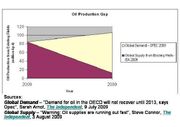Energy FAQ
Where does petroleum oil come from?
It took the earth 500 million years to store up the sun’s energy through photosynthesis and the decay of plants and animals and bank it as petroleum oil, often deep within the earth's surface. Early oil finds as in Texas and Saudi Arabia discovered oil bubbling at the surface but today oil wells are drilled deep into the earth's crust and often in the most inhospitable places. The recent giant find off the coast of Mexico is deeper than Mount Everst is tall and in the hurricane-prone Gulf of Mexico. Today we are consuming oil at a rate that will see all that energy depleted in two centuries.
How much oil is there?
The US Geological Survey estimates (2000) that the maximum recoverable amount of conventional oil is 3 trillion barrels (a figure that is highly disputed and more likely to be between 2-2.25 trillion barrels). Since oil was first pumped out of the ground, the world has consumed 1.1 trillion barrels of oil, 90% of which has been since 1959 and 50% of which has been since 1986. So we currently have used up between ⅓ and ½ of conventional oil and are doing so at an ever increasing rate.
Global oil discovery peaked in 1964. US discovery peaked in the late 1930s and US production peak in 1970. Russia’s production peaked in 1990, the UK in 1999, Norway in 2001, and Mexico and Canada in 2004 (B.P. Statistical Review of World Energy, 2006). Recent reports have also suggested that Mideast suppliers have overstated their oil reserves by as much as 1/3.
While there is general agreement that there is lots of oil in the ground, the big problem according to David Hughes at the Ecological Survey of Canada is deliverability, the capacity to get it out of the ground and to the gas pumps. For instance, global super tanker capacity and oil rig infrastructure peaked in the 1980s. A massive amount of infrastructure needs to be built to accomodate the increasing levels of demand.
How much oil does the world consume?
The global economy consumes approximately 85 million barrels per day or roughly 30 billion barrels of oil (1.2 trillion U.S. gallons or 4.8×109 m3) each year[2]. This amount is so huge it has led to a new volume unit "one cubic mile of oil", as a rough approximation of global consumption.
Are we running out of oil?

The International Energy Agency (IEA) estimates that the decline in oil production in existing fields is running at 6.7 per cent a year. According to an August 2009 report by the IEA, even if demand remained steady, the world would have to find the equivalent of four Saudi Arabias to maintain production, and six Saudi Arabias if it is to keep up with the expected increase in demand between now and 2030.
What is meant by 'Peak Oil'?

Distribution of world oil production suggested by King Hubbert in 1956
Peak oil refers to the point in time when the maximum rate of global petroleum extraction is reached (ie. we are consuming more than we are able to extract from the ground), after which time the rate of production enters terminal decline because petroleum is a non-renewable resource. The concept is based on the observed production rates of individual oil wells, and the combined production rate of a field of related oil wells.
The underinvestment by the oil industry today due to the recession and tight capital flows will play out as a tighter oil crunch probably by 2015. It takes an average of six and a half years from finding an oil field to bringing it on stream and, in the rare case of giant fields, often more than 10 years.
How big is global oil demand?
According to OPEC by 2030, global demand for OPEC oil will hit 106 million bpd from current 84.2 million bpd in 2009 – a 25% increase. Growth will come from developing countries, their consumption rising by 23 million bpd between 2008 and 2030. However, the IEA data suggests that existing fields will supply less than 15% of existing demand levels by that time.
In the 2008 International Energy Outlook published by the US Energy Information Administration projects oil prices to fall to $56 per barrel by 2016 and rise modestly to $70 per barrel by 2030 (in constant 2006 USD).
How big is oil demand in developing counties?
Lester Brown has calculated some sobering statistics based on the average Chinese being as prosperous as the average American by 2031. If they consume resources to the same degree as Americans do today, that implies 99 million barrels of oil per day (almost 14 million barrels more than the entire world production today); 1.1 billion cars (or almost 50% more than the world total today);1,352 million tons of grain (or 2/3 of the entire world’s grain harvest of 2004); 303 million tons of paper (double current world production); and 2.8 billion tons of coal (300 million tons more coal than current world production).
"The expansion of all economic energy sources will be required to meet demand reliably till 2030”, Lee Raymond, former CEO ExxonMobil. That is, we’ll need every ounce of oil we can find to get through the next 25 years.
As the world economy comes back from recession, global demand for oil is expected to rise 50-60% by 2030, especially with developing countries.
I thought the recession was due to the collapse of financial markets?
According to Jeff Rubin, formerly the Chief Economist at CIBC, the sky high oil prices in 2008 that were caused by overheated demand for oil were what ultimately caused the financial system’s house of cards to collapse and the current recession as previously occurred with the oil embargo of 1973, the Iranian revolution of 1979 and the Kuwait War of 1990.
What is the connection between oil and the economy?
Our economy has replaced the use of human energy with oil energy. The energy output of a single person doing manual labour, averaged over a period of days, is equivalent to about 200-300 British Thermal Units (BTUs) per hour. A single gallon of gasoline contains about 150,000 BTUs of potential energy, roughly equivalent to 500-750 hours of hard human labour.
A barrel of oil is therefore the equivalent of eight years of human labour. At that rate and given minimum wage of $10 per hour, the price of a barrel of oil should be about $160,000.
But we use petroleum not just as a fuel to burn but as fertilizer for our food, as a source for pharmaceuticals, for cosmetics, and for clothes. It is used to generate electricity for our computers and cell phones. We use oil in the production of cement and for the steel we make for cars, all types of heavy equipment and even for the production of wind turbines and photovoltaic cells that are meant to replace oil. In short our entire economy is entirely dependent on oil and natural gas.
Despite this dependency, we have constructed an economy that is dependent on continuous growth and ever increasing levels of oil consumption to sustain that growth. From a scientific perspective, the idea that any system can grow continuously is absurd.
“The notion of unlimited economic growth with reduced energy consumption must be put to rest beside the equally appealing but impossible idea of perpetual motion.” (Bob Costanza, “Embedded Energy and Economic Valuation”, Science, vol. 210, December 12, 1980.)
We use more oil because we demand more growth. But as increasingly apparent, growth does not always enrich us. Economic growth has de-coupled from economic prosperity in almost all western nations. In 1979 dollars the real income of Americans, for instance, has dropped 5.2% from 1979 to 2005. As growth continues, it is increasingly evident that economic inequality is also increasing. The old adage “growth lifts all boats” no longer applies. Growth benefits disproportionately fewer and fewer people in every country.
Moreover, economic growth seems less and less relevant to the happiness of people who have already attained their basic physiologic and safety needs. The greatest levels of consumption occur within those populations which are least in need of it. In fact, the growing pursuit of satisfaction from consumption of goods has been accompanied by reduced overall levels of happiness in society. Happiness peaked in the US somewhere in the 1950s and since then it has been slowly declining. Money and happiness are correlated up to $10,000 per capita income -- as they are in developing countries. After that the correlation disappears.
What is EROI?
Early oil EROI, Energy Return on Investment, was 100:1 meaning 100 units of energy were returned for each unit of energy used to obtain it. New discoveries today, like the deep ocean wells off Mexico and Brazil have drastically reduced EROI's, more like 8:1. Wind energy is about 20:1; tar sands EROI is 6:1; nuclear is 4:1; corn ethanol is approximately 1:1 (or less); and coal liquification about 0.5:1. If it takes more energy to produce might as well leave it alone.
While the size of our homes has gone from 983 square feet in 1953 to 2434 square feet in 2005 (National Association of Home Builders), the average number of people living in those homes has steadily declined since 1900. In1986, the average size had dropped to 3.1 people (Vanier Institute) and by 2006 the average size of a Canadian household had shrunk to 2.5 people (StatsCan).